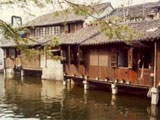 Wu Zhen is a small, ancient town in northern Zhejiang. Local people are proud of their traditions here and life has changed very little for generations. Check out Zhejiang Special to find out more about its customs and the simplicity of life there.
Wu Zhen is a small, ancient town in northern Zhejiang. Local people are proud of their traditions here and life has changed very little for generations. Check out Zhejiang Special to find out more about its customs and the simplicity of life there.
Wu Zhen is an important center for silk production in northern Zhejiang. Every year in April, local farmers hold grand ceremonies to pray for the good harvest of silkworm cocoons. The ceremony is called "Xiangshi", literally meaning "incense fair".
The part you've been listening to is an important part of the ceremony. It's performed to commemorate a legendary figure called Wen Yuanshuai, or "the Commander of the Gods of Plague". Local people believe the Commander will help protect their silkworms from being destroyed by plague.
The performance is something quite similar to traditional Peking Opera. In their flamboyant, brightly coloured costumes, there are some 50 performers taking part in the parade. Some beat gongs to clear the way, others carry a big jar of wine and an iron pot containing burning logs, still others escort the procession with swords, spears and flags of all colors.
According to records, the site of Wu Zhen used to be the frontier of the Kingdom of Wu against Yue, during the Spring and Autumn Period. It developed into a town in 875 A. D., and was once an important collection and distribution center in northern Zhejiang thanks to its excellent waterways. Its population exceeded 100-thousand during its golden era. The figure now is a little more than 40-thousand. The typical water village dwellings, characteristic of southern China. were built during the Qing Dynasty and have been very well preserved here.
Wu Zhen's traditional "incense fair" has a history of more than 200 years. Over the years, it has not only been an occasion for praying for good harvests and good fortune, it has also become a carnival, and now attracts hundreds of thousands of farmers from neighbouring towns and villages. Local opera performances, variety shows and lion dances are all favourites.
Another attraction of the small town is its special hand-made cotton print, and the process of making it.
The cotton print, a traditional handicraft, is deep blue in colour and decorated with white designs. It's used by every family in town for curtains, scarves, aprons, table cloths and so on.
Unlike the wax print, the cloth is dyed while starching in a mixture of limewater and soya bean powder. The dye is a plant called Lan Cao, or radix Isatidis. Each of the designs is unique.
65-year-old Shen Caijin is weaving cloth. The loom is made of wood and bamboo and looks very complicated. It's more than 100 years old and was first used by Shen Caijin's great grand mother. Although it produces only 3 meters of cloth every day, Shen is proud of her loom. She says the cloth she makes is twice the price of that made by modern machines, but it's eagerly sought after.
"It's all hand-made, everything, from cotton ginning and spinning to weaving and dyeing. So of course it's a bit expensive. I learned to do this when I was just a kid, and I'm sorry that none of my four children have learned to use the loom."
Shen Caijin's next-door neighbor is an old man spinning thread with a homemade device as old as Shen's loom. A few yards away from their house, is a small workshop for printing and dyeing. The finished products are hung high along bamboo poles. Flapping in the wind, they create a charming and idyllic scene against a backdrop of simplicity and mystery.
(CRI November 18, 2002)
|

